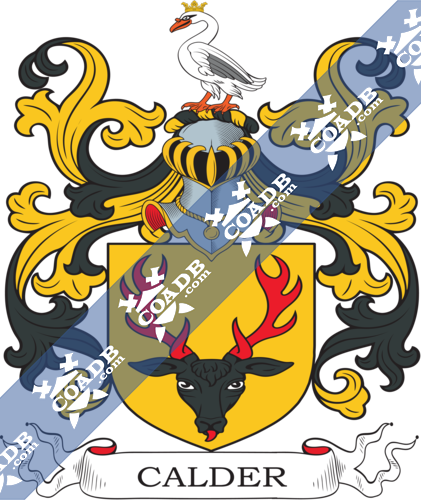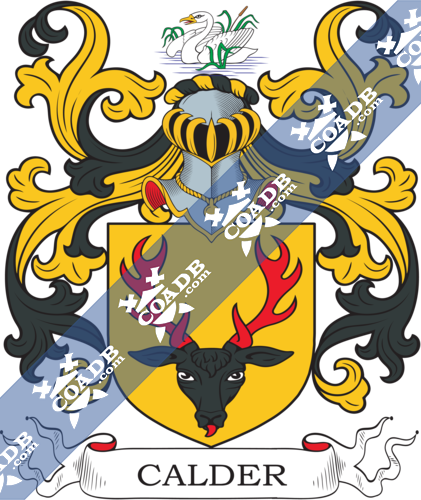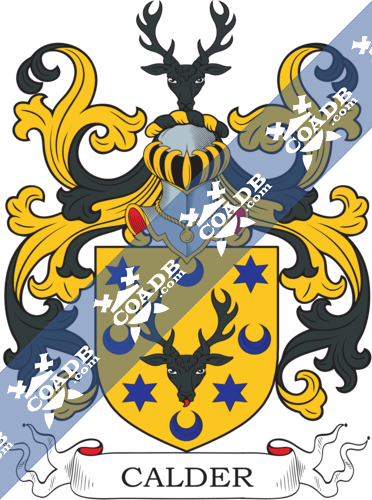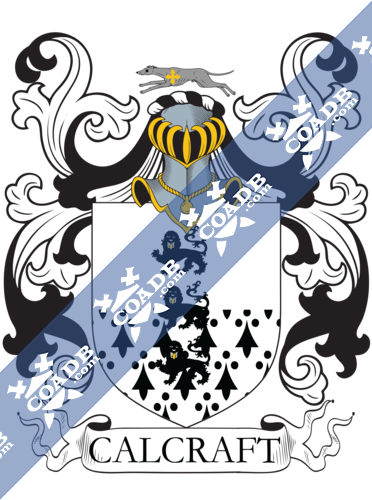Calder Family Crest, Coat of Arms and Name History

Calder Coat of Arms Gallery
Don’t know which Coat of Arms is yours?
We can do a genealogical research. Find out the exact history of your family!
Learn MoreSurname Name Meaning, Origin, and Etymology
Pronunciation: KAHL-der. The Calder surname is a habitational last name of early Scottish and English Medieval origin. The surname presumably derives from the early Common Brittonic word of Welsh origin “caled,” which translates into “hard”. Named from the river upon which it rested, which likely once flowed with hard and violent water. Historians believe the surname to be a locational name from Calder in Cumberland, or the other various locations throughout Scotland where slight variations of the name are seen such as Cawdor, Calder, and Calderwood.
Spelling Variations
Spelling variants of the Calder surname with comparable etymological origins include Calder, Caddell, Cawdor, Caldille, Cadder, Cauder, Caudor, Kaledouer, Caldell, Cattell, Cadel, Cadwell, Codel, Coddel, Kauder, and more.
Popularity & Geographic Distribution
Although the surname is comparatively uncommon in the United States, more individuals bearing the Calder surname reside in the United States than in any other country in the world. Currently, 6,444 people sharing the Calder last name live in the U.S., ranking it 6,046th in popularity. The surname is most prevalent in the western part of the country followed by the eastern part of the county, and the least prevalent in the mid-western states. England falls close behind the United States in Calder surname popularity, where approximately 4,851 people bearing the same last name currently live in the country, ranking it 1,631th in the nation. Canada falls third on the list, where an estimated 3,237 individuals with the last name of Calder reside, ranking the surname 1,593th in the country. Surprisingly due to the its origins, Scotland falls fourth on the list with 2, 533 people currently residing in the country who share the Calder last name, ranking it 325th most common last name in the country. Likely due to its historic connections to Britain, South Africa ranks fifth on the list, with 2,393 individuals currently residing in the nation who share the Calder surname, ranking it 2,718th in the nation. Currently, an estimated 25,709 individuals sharing the Calder surname reside across the globe, making the last name the 20,187th most common surname in the world.
Early Bearers of the Surname
The earliest recording of the Calder surname was noted as “Cumbria” in the 1179 Pipe Rolls of Scotland, and then again in 1231 as “Kildre”. Calder was next recorded in the town of Thurso, Caithness (Northern Scotland) during early thirteenth century as “Kalfadal,” a name likely deriving from “kalf” which translates into “calf”, and “dair” which translates into “valley.” Early examples of the recorded name include Adam De Calder in 1170, Cumberland, and Donal of Calder, Dunmanglas, Iverness, in 1419, where the noble family held a seat, followed by John Calder, who was documented in the Exchequer Rolls of Scotland, in 1589.
History, Genealogy, and Ancestry
Historians believe the Calder surname first rose to prominence in Scotland through Hugo deCadella, a French nobleman. According to the writings of the late fourteenth century Scottish historian, David Hume of Godscroft, Hugo deCadella first arrived in Scotland around 1060AD, during the Norman Invasion. The nobleman is said to have created the Thane of Calder (a nobility title in Scotland), later known as “Thane of Cawdor”. During this time period, it was common for Norman knights to marry Celtic heiresses, acquiring land dowries throughout the region as a result of the intermarriage. The Calder surname increased in popularity during the thirteenth century in Dunmanglas, Iverness, where the prominent Calder family was of nobility, owning an abundance of land. Notably, in the early narrative of William Shakespeare’s play Macbeth, the main character becomes “Thane of Cawdor”.
Clan Calder is noted to have intermarried with other families of local origin such as Clan Rose, Baron of Kilravock. The direct ascendency of the Calder Clan ended with the ninth Thane (Thaness) of Cawdor, an infant by the name of Muriel Calder. Following the untimely death of her father, the eighth Thane of Cawdor, Muriel Calder, the female heir to the Calder family, was forcibly kidnapped by Archibald Campbell, the Chief of the Campbell Clan and second Earl of Argyll. Campbell quickly decided to remove Muriel from her from Kilvarock Castle, where she was being cared for by her grandmother, and move her to the Inveraray Castle, with the intention of raising and educating her as part of the Campbell family. During the abduction, little Muriel’s nurse branded the infant with a red-hot key, in the hopes that if the child was found, she could one day be identified. The chief of the Campbell Clan quickly faced forceful opposition from two of Muriel’s uncles, Hugh Calder and Alexander Calder, who chased the infant and her guardian all the way to Strathnairn. Although Archibald Campbell lost six of his sons during the violent pursuit, Muriel Calder eventually arrived at Inveraray Castle safely. The infant was subsequently raised a Campbell and eventually forced into a marriage with Sir John Campbell, the son of Archibald Campbell. Muriel Campbell returned to Cawdor in 1524 to reside with her husband. Following the death of her husband in 1546, the ‘red-haired laisse’ finally became Thaness of Cawdor and remained so until she passed away in 1575. Muriel’s descendant, John Campbell of Cawdor, became Lord Cawdor in 1796. His son became the first Earl Cawdor in the year 1827. The present-day Earl Cawdor resides in Cawdor Castle, and still holds the seat of his ancestors from hundreds of years ago. Cawdor Castle, which was built by the Calder Clan and dates back to the fourteenth century, is located five miles south-west of Nairn.
Early American and New World Settlers
According to early American Historians, the first settler to reach the New World bearing the Calder surname was Thomas Calder, who settled in Virginia in 1619, which was notably one year before the Pilgrims landed and settled in Plymouth, Massachusetts. Thomas Calder was followed more than a century later in 1720, by Robert Calder, who also settled in New England. The first person bearing the Calder surname to appear on record in the southern states was William Calder, who settled in Georgia 1735, beginning the wave of migration of individuals sharing the Calder surname that was soon to follow.
According to the United States Federal Census Record of 1840, families bearing the surname of Calder in the United States resided mainly in Massachusetts, New York, and Pennsylvania at the time, where approximately one dozen families with the last name resided in each state. Those families were followed by a handful of families each residing in New Jersey, Ohio, North Carolina, South Carolina, and Georgia. Less than a handful of families sharing the Calder last name lived in various other states along the East coast at that particular time.
By 1880, 1,145 families bearing the Calder surname lived in the U.S., ranking 5,087th in popularity at the time, as noted in the United States Federal Census of 1880. South Carolina ranked number one in the country with 169 individuals residing in the state, followed by New York with 120 individuals, Illinois with 73, and Massachusetts and Ohio tying with 71 residents residing in each state.
Mottoes
A motto is a slogan or war cry. The Calder family motto first began to appear on the family coat of arms during the fourteenth century. The family motto, “Vigilans non cadit” translates into “the Vigilant man falls not.”
Grantees
The Calder family coat of arms consists of four devices placed on a vibrant gold shield. The head of a buck (which is surrounded by ten black tynes), a swan, mullet, and a crescent are all vividly depicted on the gold blazon. The main colors forming the blazon are or (bright yellow/gold), and sable (black).
Notables
The earlier notable individuals bearing the Calder surname include but are not limited to the following: Hugh DeCadella, French Nobleman and the first noted individual bearing the Calder surname on record; Donald Calder, the first recorded Thane of Cawdor; William Calder, the second Thane of Cawdor; Andrew Calder, the third Thane of Cawdor; Andrew Calder, the fourth Thane of Cawdor; Donald Calder, the fifth Thane of Cawdor; William Calder, the sixth Thane of Cawdor; William Calder, the seventh Thane of Cawdor; John Calder, the eight Thane of Cawdor; and Muriel Calder, the ninth Thane (Thaness) of Calder.
More recent notable individuals bearing the Calder surname include but are not limited to the following: Three generations of American Sculptors by the names of Alexander Milne Calder, Alexander Stirling Calder, and Alexander Calder; New York Senator, William Calder; the first National Hockey League President, Frank Calder; Scottish football player, Bob Calder; Winter Olympian, Katherine Calder; Mormon pioneer, David Calder; Canadian politician, Frank Arthur Calder; fifth President of Pennsylvania State University, James Calder, founder of Calder publishing, John Calder; Scottish palaeobotanist, Mary Gordon Calder; historian, Angus Calder; recording executive, Clive Calder; actor, David Calder; American college basketball player, Eddie Calder; British science-fiction writer, Nigel Calder and his son, travel writer, Simon Calder; British Naval Officer, Robert Calder; Australian politician, Sam Calder; World War II Advisor to the Ministry of Supply, Sir James Calder, and many more.
Blazons & Genealogy Notes
1) (of that Ilk, co. Nairn, Thane of Cawdor. In the 16th century the heiress m. Sir John Campbell, son of the 2nd Earl of Argyll, and was ancestor of the Earls of Cawdor). (Asloune). Or, a buck’s head cabossed sa. attired gu. Crest—A swan ppr. crowned or.
2) (Lynegar, co. Caithness). Motto—Vigilans non cadet. Or, a buck’s head erased attired with ten tynes sa. within four stars and as many crescents alternately disposed orleways az. Crest—A stag’s head cabossed sa.
3) (Muirtown, bart. 1686). Motto—Vigilans non cadet. As Calder, of that Ilk. Crest—A swan naiant in a lake with bulrushes therein all ppr.









